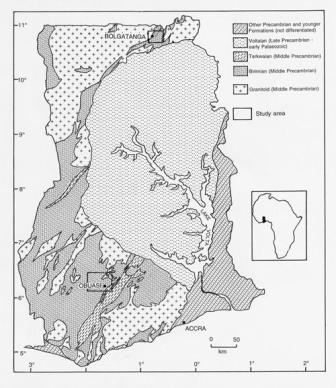Arsenic in groundwater in Ghana
Ashanti Region in Ghana has been a centre of major gold-mining activity since the late 19th century. One of the main mining towns is Obuasi.
The principal gold-bearing ore is arsenopyrite (FeAsS) and the mining activity is known to have given rise to substantial airborne arsenic pollution from the ore-roasting chimney in the town as well as riverborne arsenic pollution derived from nearby tailings dams.
A project funded by the UK government's Department for International Development (DFID) was undertaken between 1992 and 1995(DFID Project R5552) in collaboration between BGS and the Water Resources Research Institite, (WRRI), Accra, Ghana.
The DFID project involved sampling of streams, shallow dug wells and tubewells used for drinking water in a 40 by 40 km area around Obuasi town. Samples of deep groundwaters (70 – 100 m depth) from mine exploration boreholes as well as mining effluent were also collected.
Results
Arsenic concentrations in water from streams, shallow wells and boreholes were found to range between <2 and 175 μg/L. The main sources are mine pollution and natural oxidation of sulphide minerals, predominantly arsenopyrite.
Streamwaters have apparently been most affected by the mining activity and contain some of the highest arsenic concentrations observed. They are also of poor bacteriological quality. Some of the streams have relatively high As(III) concentrations(As(III)/AsT>0.5), probably as a result of methylation and reduction reactions mediated by bacteria and algae.
Concentrations of arsenic in groundwaters reach up to 64 μg/L, being highest in deeper (40 – 70 m depth) and more reducing (Eh 220 – 250 mV) waters. The arsenic is thought to build up as a result of the longer residence times undergone by groundwaters and the increasingly reducing conditions in the deeper parts of the aquifer.
The proportion of arsenic (As) present as As(III) is also higher in the deeper groundwaters. Deep mine exploration boreholes (70 – 100 m) have relatively low arsenic concentrations of 5 – 17 μg/L, possibly as a result of arsenic adsorption onto precipitating hydrous ferric oxides or to localised low concentrations of arsenic-rich sulphide minerals.
Publications
Smedley, P L, Edmunds, W M and Pelig-Ba, K B. 1996. Mobility of arsenic in groundwater in the Obuasi gold-mining area of Ghana: some implications for human health. In: Appleton, J D, Fuge, R and McCall, G J H (editors), Environmental geochemistry and health: with special reference to developing countries. Geological Society Special Publication 113, 163–181.
Smedley, P L. 1996. Arsenic in rural groundwater in Ghana. Journal of African Earth Sciences, 22, 459–470.
Contact
Contact Dr Pauline Smedley for further information







